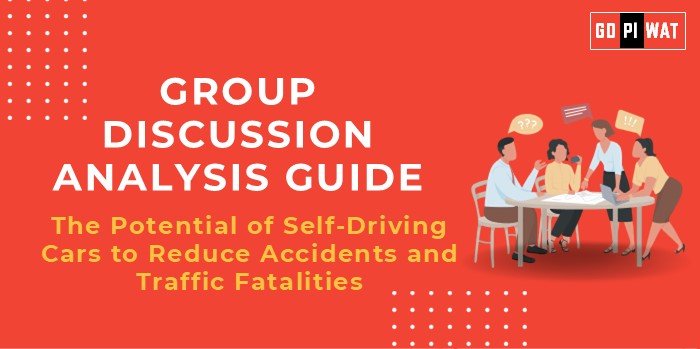📋 Group Discussion (GD) Analysis Guide
💡 Topic: The Potential of Self-Driving Cars to Reduce Accidents and Traffic Fatalities
🌟 Introduction to the Topic
- 💡 Opening Context: Self-driving cars are at the forefront of modern technological innovation, promising to revolutionize transportation by reducing accidents and fatalities caused by human error, which accounts for over 90% of road mishaps globally.
- 📖 Topic Background: The concept of autonomous vehicles emerged in the mid-20th century but gained momentum with advancements in AI and machine learning. The global push for safety and efficiency in transportation has accelerated the adoption of self-driving technology. Notable milestones include Waymo’s pilot programs and Tesla’s semi-autonomous features.
📊 Quick Facts and Key Statistics
- 🚗 Human Error in Accidents: Causes over 90% of road accidents worldwide.
- ⚠️ Annual Global Road Fatalities: Over 1.3 million (WHO, 2023).
- 📈 Self-Driving Technology Market: Projected to reach $300 billion by 2030.
- ✅ Reduction in Collisions: Self-driving technology could cut accidents by up to 94% (NHTSA).
👥 Stakeholders and Their Roles
- 🚗 Automakers: Innovate and manufacture autonomous vehicles (e.g., Tesla, Waymo).
- 🏛️ Governments: Regulate safety standards, testing protocols, and infrastructure.
- 💻 Tech Companies: Develop AI, sensors, and mapping technologies (e.g., NVIDIA, Mobileye).
- 🌍 Consumers: Adoption drives the market, influencing innovation.
- 🛡️ Insurance Companies: Adapt policies to cover risks and benefits.
🏆 Achievements and Challenges
Achievements:
- 🔒 Safety Innovations: AI-powered systems drastically reduce driver error.
- 🚦 Traffic Management: Smart algorithms optimize traffic flow, reducing congestion.
- 💰 Economic Savings: Decrease in accident-related costs ($871 billion annually in the U.S.).
Challenges:
- 💵 High Costs: Prohibitive for mass-market adoption.
- ⚖️ Ethical Concerns: Decision-making during unavoidable accidents.
- 📜 Regulatory Hurdles: Varying standards across nations.
🌐 Global Comparisons:
- 🇸🇪 Success: Sweden’s Vision Zero reduced road fatalities with self-driving pilot programs.
- 🇺🇸 Challenges: U.S. faced mixed results in public trials due to unclear laws.
💬 Structured Arguments for Discussion
- ✅ Supporting Stance: “Self-driving cars have the potential to save millions of lives annually by eliminating human error, the leading cause of road accidents.”
- ❌ Opposing Stance: “The technology is still in its infancy, with unresolved issues like cost, ethical dilemmas, and public trust.”
- ⚖️ Balanced Perspective: “While self-driving cars promise revolutionary safety benefits, addressing regulatory, ethical, and infrastructural challenges is critical for successful integration.”
🔑 Effective Discussion Approaches
- 📊 Opening Approaches:
- “With over 1.3 million annual fatalities globally, autonomous vehicles could revolutionize road safety.”
- “Self-driving cars offer not just convenience but a life-saving promise—can we afford to delay their adoption?”
- 💡 Counter-Argument Handling:
- “While ethical dilemmas exist, they are outweighed by the potential to save millions of lives.”
- “Initial costs are high, but economies of scale will make the technology affordable.”
📊 Strategic Analysis of Strengths and Weaknesses
- 💪 Strengths: Reduced accidents, optimized traffic, environmental benefits.
- ⚠️ Weaknesses: High costs, regulatory challenges.
- ✨ Opportunities: Market growth, collaboration with AI innovators.
- ⚡ Threats: Cybersecurity risks, public skepticism.
📚 Connecting with B-School Applications
- 🌍 Real-World Applications: Topics in operations, AI-driven efficiencies, and ethical AI decision-making align with B-school case studies.
- ❓ Sample Interview Questions:
- “Discuss the ethical challenges of self-driving cars.”
- “How can AI integration enhance supply chain logistics using autonomous vehicles?”


